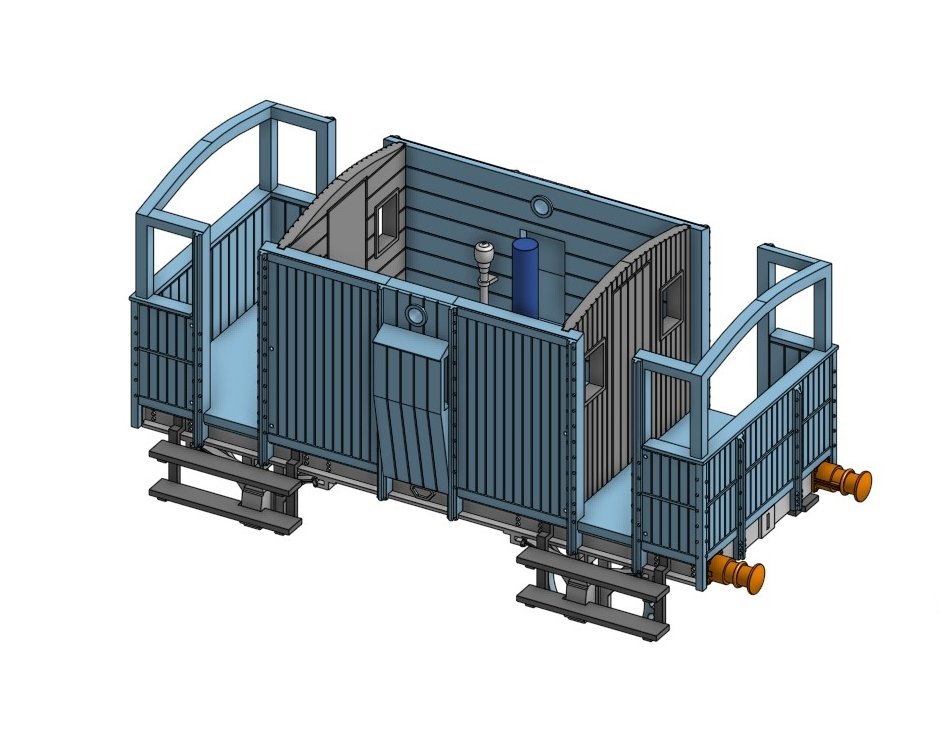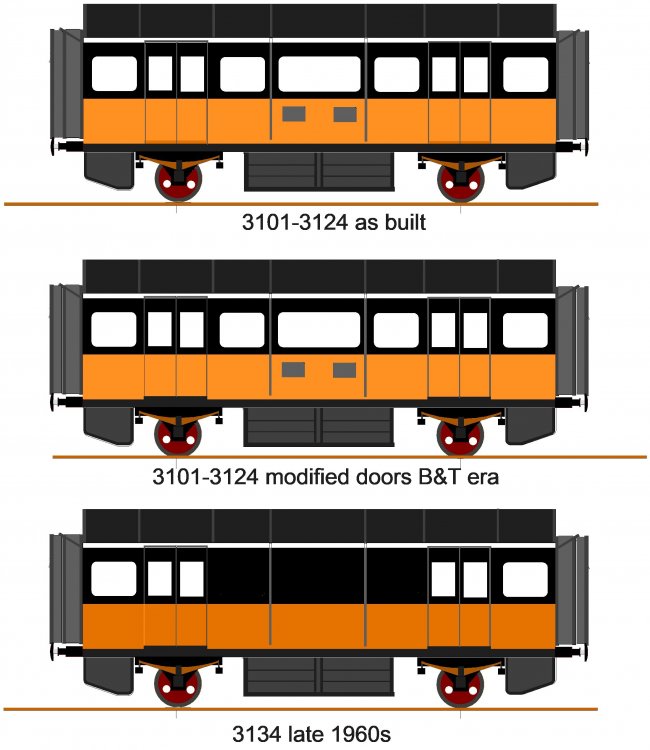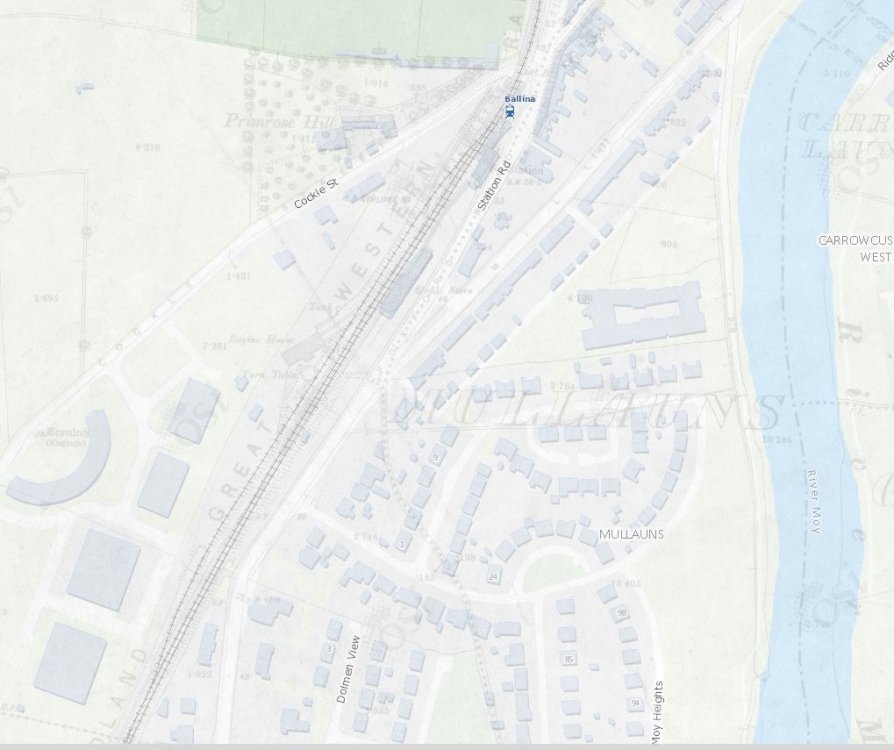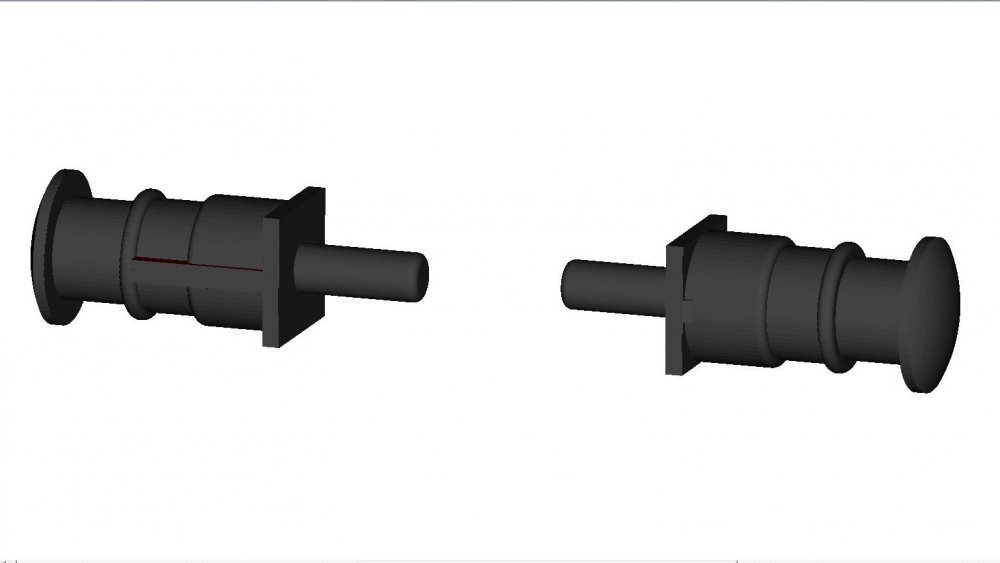-
Posts
4,858 -
Joined
-
Last visited
-
Days Won
119
Content Type
Profiles
Forums
Events
Gallery
Blogs
Store
Community Map
Everything posted by Mayner
-
Many of the earlier American Road Switchers were set up to run long-hood or bonnet forward as it gave better collision protection to train crews, Norfolk & Western, Southern Railway later Norfolk Southern were the last of the major American railroads to hold on to this tradition. There is a story that when originally introduced some drivers turned the B121 locos to run bonnet first. Grills/louvers were fitted to the cab doors of the B121 Class and a requirement to run cab first was introduced following an incident involving a p.w. workers at Straffan in the early 1960s. T The p.w. gang had placed detonators and a flagman to protect a possession while replacing a rail, apparently the loco crew may not have noticed the flagman because of poor sighting or have heard the detonators (sound insulated cab) to stop before entering the possession. The grills/louvers disappeared from the cab doors at some stage during the IE eras.
-
Several of the proposed schemes in Ireland could come with a hefty price tag to compensate existing landowners as lines like the SLNCR & West Clare were abandoned and the trackbed mainly sold to adjoining farmers. There are a number of examples of heritage railways co-existing with cycleways and bridlepaths including the Waterford & Suir Valley, Carenarfon-Dinas section of the Welsh Highland and Northampton & Lamport in the East Midlands. Interestingly about 10 years ago the New Zealand Government considered converting sections of the national rail network as part of the National Cycleway Project to stimulate the economy in the wake of the 2008 Great Financial Crisis. https://en.wikipedia.org/wiki/New_Zealand_Cycle_Trail. In the end someone pointed out that rail was essential to export industry and no operational lines were converted to cycleways though a number of mothballed lines were converted to rail carting operations. The National Cycle Way and various rail carting operations has been good in supporting local economies in remote areas where rural -depopulation has become a serious problem with the decline in traditional small scale framing and rural support industries Rail cycling (Velo Rail) http://veloraildefrance.com/ and Rail Carting https://www.forgottenworldadventures.co.nz/routes-and-trails/category/2/rail-cart, would seem to be good alternative uses to Cycleways for "mothballed" lines, but liability issues with level crossings and a new and novel form of rail operation would probably be un-surmountable problems in Ireland
-
It looks like Drimoleague may have discovered a rare find & it looks to be in quite good condition. There is a photo of 203D an ex-Dublin Wicklow & Wexford Railway (DWWW) bogie coach with similar paneling arrangement and profile on page 27 of Des Coakham's Irish Broad Gauge Carriages. The second photo with the open door indicates that the coach has a slight tumblehome in the sides rather than being slab sided. 203D appears to be one of a pair of 44' bogie coaches built by Birmingham Carriage and Wagon in 1895 before Richard Cronin took over as engineer and began introducing coaches with a high parabolic roof that became a distinctive feature of DWWW and later Dublin and South Eastern Railway Coaching stock. Its possible that there may be photos of similar coaches in Ernie Shepherds Dublin & South Eastern pictorial.
-
The CIE 20T brake vans are listed in the 23500-23664 series introduced in 1950 in both "Irish Railways Today" and "Locos and Rolling Stock of CIE and NIR". There appears to be considerable detail difference between individual vans as many appear to have been rebuilt with pressed metal lookouts and planking obscured/replaced with aluminium or ply sheeting as vans were re-built during the 1960s. The model is based on a broadside photo of 23586 that appeared in an article on CIE/GSWR Brake Vans the February 1977 edition of Model Railways. Its likely that pressed metal duckets and aluminium/ply sheeting was fitted on an ad-hock basis when body work on individual vans required major repair/replacement, 23508 one of the earliest of the series appears to have been re-built at some stage with metal duckets and body sheeting, while retaining vertical veranda planking.
-
Our original plan was to design a van that could be retro-fitted with functioning lamps. Fitting the van with working lamps would have added considerably to the cost and complexity of the model. At this stage we have designed the lamps as a solid due to problems in designing a hollow lamp housing with adequate wall thickness. TimO We are not planning to fit the van with torpedo vents, there appears to have been a lot of detail variation between van in later years the photo of 23544 is the only 20T van that I have seen with torpedo vents.
-
Approaching another milestone in the design process as we finalise the CAD work before we produce the prototype for the production model. There are a few final tweaks to be made to the CAD work including trimming the stove pipe to fit within the roof and adjustments to the buffers and brake gear and fitting the side lamps. All going well we expect to have a pre-production sample ready in approx two to three weeks.
- 62 replies
-
- 11
-

-
To provide clarification, I am planning to supply the models as kits as I am not currently undertaking rtr commissions. The TPO was supplied with parts to assemble the van in its original condition as a PO Van or as a PW riding van similar to that preserved at Downpatrick. There is a detailed thread on assembling a Tin Van on p3- in Georges Workbench.
-
Although a number of 21mm gauge layouts have been built to EM gauge standards, I don't know if anyone has actually built a layout to 20.2mm gauge. 20.2 appears to have been developed by Martyn Wynne as an EM gauge +2mm in a similar manner to his advocacy of 16.2 mm as EM-2mm for OO. In practice it is perfectly feasible to build a 21mm layout to EM gauge running clearances with a back to back gauge of 19.3mm & a wheel check gauge of 19.95 using EM profile wheels. The use of EM standard wheel sets should not have a significant distorting effect on the width of a model as the difference in wheel set width between the two standards is marginal, as the effects of the difference in back to back gauge and tyre width largely cancel each other out 21mm B-B TW WOWS EM 19.3 2.28 23.86 P4 19.92 2 23.92 Max P4 19.84 1.85 23.54 Min 23.73 Avg.
-
I am updating the Heating & Luggage and Luggage Van kits in a similar manner to the TPO with an additional set of sides, to allow a different variation of the model to be assembled. The Post Office Van was designed to be assembled in its original form or in their rebuilt for as P.W. Tool Vans which were used with Weedkiller & track re-laying trains in the 80s & 90s one of these vans survived as the "Heuston Tool Van" and now resides at Downpatrick. Heating & Luggage Variations. The kit includes alternate sides to assemble the model as a 3101-3124 series van or as 3134 with a number of boiler room and luggage compartment windows replaced by plain panels. 1. 3101-3124 As built 1955 with bottom edge of outward opening doors flush with bottom edge of floor and sides. 2. 3101-3124 With modified outward opening doors late 1950s onwards. I have incorporated a half-etched line on the inside edge of the doors, to allow the bottom edge to be neatly snapped off for this modification. 3. 3134 with blanked off boiler & luggage compartment doors. I don't know if 3134 was built in this form or the blanked off windows were a modification as 3134 appears to be from a later series of vans. The final (1959-60?) batch of Tin Vans" were built with recessed inward opening doors, but have the same window and vent details as the original 1955 vans. Luggage Van Variations. The kit includes alternate sides to assemble the vans in their original form or as 2749 with a number of windows replaced by plain panels. The replacement of glazed with plain panels appear to have been ad-hoc repairs to keep the vans in service. There is a photo of one van (2727) single plain panel. The 4w Luggage Vans were withdrawn from service in the early 70s following the introduction of the BR Vans & the conversion of older coaches into Vans (BSSGV & Parcel/luggage) A small no of 4w Luggage Vans were retained for Connolly-Dunlaoire Pier Mail and Parcel trains, these vans were restricted to 35mph lost their gangways and were re-painted in all over "Golden Brown" similar to the contemporary Dublin City bus scheme. Some redundant Luggage Vans had a final main line fling, rebuilt into two rakes of "coaches" for the First Great Train Robbery movie with main line steam running behind 184 & 186 on the Mullingar-Athlone Line.
-
The DSER rebuilt 64 Earl of Bessborough (GSR427) with a high pitched boiler and DSER cab so that it was almost un-recognisable as a LNWR 4'6" tank, there is a photo of 427 about half way down Page 7 on JHBs From the Catacombs thread. The Mercian LNWR 5'6" radial thank might be a better option than a 4'6" tank for an Irish conversion as WLWR 13-14 (GSR 267 & 491) have a striking resemblance to the LNWR locos including cab and bunker profile.
-
Some good news Clare County Council approved a planning application for a 1506SqM Railway Museum at Moyasta during Nov 2019. https://www.planningalerts.ie/application?pref=555AA620181195A5C00024809833CEAC097DFD I don't know if the application relates solely to a museum/store for ITG stock or a West Clare MuseumThere is a €29.37 subscription to view the file on-line. The ITG had applied and failed to obtain planning permission several years ago as a large industrial (museum) building would have been out of keeping with the open (windswept) landscape of the area The ITG web site admits that some of the locos are long term restoration projects and some are simply stored as a source of spares.
-
I have received enough expressions of interest to proceed with a second batch of these kits for release in late 2020. Please send send me a p.m. or respond to this thread if you are interested in placing an order. Heating & Luggage. Luggage Post Office Van
-

Ernies Massive Irish 1930's to 2005 Photo Archive
Mayner replied to Glenderg's topic in Photos & Videos of the Prototype
There is a series of photos of the Bann Viaduct on https://www.geograph.ie/snippet/3725. It looks like the viidaudct opens for shipping. -

Ernies Massive Irish 1930's to 2005 Photo Archive
Mayner replied to Glenderg's topic in Photos & Videos of the Prototype
There are a number of photos of the 15 March 1959 Baltinglass Fair Special in the O'Dea Collection in the National Library, this appears to have been the final revenue working on the Tullow Branch. The train appears to have acted as a positioning run for the branch lifting train the loco continued to Tullow with the coaches and P.W.D stock after dropping the cattle wagons at Baltinglass. http://catalogue.nli.ie/Collection/vtls000148612/Home?lookfor=tullow&filter[]=era_facet%3A"1950-1960"&filter[]=authorStr%3A"O'Dea%2C+James+P.+1910-1992+photographer"&filter[]=topic_facet%3A"Railroads"&submit=Apply It looks like the photo of the Sleeping Van and pwd. stock was taken at Dunlavin (concrete station building and loop lifted) http://catalogue.nli.ie/Collection/vtls000148612/Home?lookfor=Dunlavin&filter[]=era_facet%3A"1950-1960"&filter[]=authorStr%3A"O'Dea%2C+James+P.+1910-1992+photographer"&filter[]=topic_facet%3A"Railroads"&submit=Apply T -

Ernies Massive Irish 1930's to 2005 Photo Archive
Mayner replied to Glenderg's topic in Photos & Videos of the Prototype
I have a copy of the 1960 CIE WTT. Senior seems to have been spot on: 40mph was the line limit for loco hauled trains on the Cork-Bantry main line Clonakilty and Skibbereen sections, while railcars were allowed maximum of 50mph on the straights. Apparently speed seems to have been restricted mainly by the lack of super-elevation or cant on curves, than the poor state of the track passenger traffic seemed to play second place to goods traffic on the West Cork in CIE days. In my experience although there is a veneer of safety in the rail industry, things have not changed a lot from the days your father was a District Engineer on the LMS. As a health and safety inspector I once persuaded a railway operator to shut down re-modelling work on the approach roads to a large intercity terminal, because of similar problems to those observed by Senior while working on the LMS in England. The disturbing thing was that workers were allowed to work in dangerous conditions despite daily safety audits by 3 different Departments. Each department had a siloed mentality and although there was high level planning there was little co-ordination at site level, and were blind to the risks they created for each other. Although the job was audited daily by the Civil Engineering (CE), Signal & Electrical (SE) & PW Departments, there was no shortage of paperwork & PPE, no one seemed to realise that CE and S&E operations were creating highly dangerous conditions for the PW workers pre-fabricating the new trackwork and the guys on site apparently accepting these conditions as a matter of course. Luckily no one was killed or hurt, the voluntary shut down avoided the adverse publicity for the railway of a trip to the Courts, it took two weeks to re-open the job. When I got back to the Office the main concern was the Chief Executive would be unable to go home by train as he thought I had shut down the station. -
The Minister is probably correct with a placeholder livery, it does not quite match any of the standard GM American or Export colour schemes. The single cab may have been to keep costs down and speed delivery using standard jigs and parts while GM worked on developing the double cabbed B141 Class which were delivered approx 2 years later. CIE engaged Scandinavian (Swedish?) consultants to come up with a new corporate image for its road and rail services in the early 60s. The consultants apparently recommended paint buses and passenger trains in the same black and tan scheme, but the powers that be in the passenger road section had other ideas with Dublin City Services, Provincial, CIE Tours each adapting their own distinctive liveries.
-
Both the Crossley and GM powered Metrovicks tended to become a lot dirtier when in service than the pure-bread GM locos, both had 2 stroke engines which tend to smoke rather than throw out oil when worn. Grimy 001 & (B)201 Class locos tended to outnumber clean members of both classes during the Supertrain era. I think the Metrovick body profile with raised engine room vents curved roof profile and slab sides and possibly oil leaks were the main factors soot and grime that collected on the roof tended to wash down over the sides and ends of the locos in typical Irish weather.
-
The rail code number is the rail height expressed in Thou (or thousand of an Inch) thus Code 83 is 8 Thou or .0008" higher than Code 75. Peco Code 75 and 80 track systems were designed for two totally different markets. Peco Code 75 Streamline was designed to provide a closer to scale rail height than the existing Code 100 for the UK and Continental markets. Pointwork geometry is similar to their existing Code 100 Streamline system. Peco Code 83 was designed as an NMRA (National Model Railroad Association) compliant system specifically for the North American market and pointwork. Code 83 point geometry is based on prototype practice and quite different to the Peco Streamline systems. For someone starting out with their first layout the difference is mainly appearance between Peco Streamline Code 100 and Code 75 track systems, both are available with wooden sleepers, with a similar range of points and crossings. Peco provide a useful summary of their different "Streamline" track systems https://peco-uk.com/collections/streamline/75?page=2&view=12&layout= Code 100 is the safest option for someone running older (pre-1990) models with deeper/coarser wheels particularly Lima, Triang, Triang-Hornby), Code 75 with the lighter rail section is probably easier to work with (easier to curve) than the larger Code 100 rail section.
-

Ernies Massive Irish 1930's to 2005 Photo Archive
Mayner replied to Glenderg's topic in Photos & Videos of the Prototype
The compartment with the sloping roof was described as a "dog box" by Padraic O'Cuimin in his IRRS paper on MGWR Coaching Stock in the early 1970s, the final design of MGWR was more conventional in outline with a full height tack compartment replacing the dog box. Before the invention of the motorised horsebox in the 1920s & 30s horses and hounds would have been transported by passenger train to hunts and equestrian events in different parts of the country, similarly horse drawn carriages and wagons would have been transported by carriage truck. -
I don't think any land was sold off, the present freight yard was built in the 1970s on the site of the loco depot. The yard was originally laid out with two through roads one served by a gantry for container traffic, the second for palletised cement and fertiliser traffic. The reach stacker requires a wider space to operate than the gantry with containers stored in the area once occupied by the cement store and fertiliser storage area. The goods yard was originally on a narrow site between what is now the main running line and station road, a short section of the Killala line known as the "Crossmolina Siding" was retained as a goods yard after the branch closed in the late 1930s.
-
Thanks to everyone for their comments and photos of the stoves, the stove is likely to be an interesting challenge to my 3D designer more natural and organic in shape than the rest of the van Broithe's comments about Brigg reminds me of the scene from the "Biderbech Trilogy" with the East/West German style border crossing when Trevor & Jill see off a visitor at a foggy Humber Bridge. The 20T goods brakes were more popular with the guards than the more modern 30T versions, they were supposed to have a better brake and being more smoother riding. The interior of of 20T vans with double planking and a wooden roof would have been less subject to extreme heat and cold and more comfortable that the all steel 30T vans with no wall or roof insulation.
-
I suppose the big question is whether there is greater demand for an Irish "Starter Set" at the toy or model end of the market. A wooden 2-3 car Intercity railcar or DART set either locally made or imported would probably be a hit with children in the 3-5 age group as these trains are more likely to fit in with their parents formative experiences. Bachmann and to a degree Hornby still cater for the entry level toy train market with Thomas the Tank Engine and their more basic models, but an Irish pre-teen or teenager starting out in model railways is more likely to be interested in the trains they see every day railcars and the odd freight than something that attracted their grandparents generation. In my opinion an existing basic but durable model in IE or Translink colours like the Bachmann IE railcar repaints was a good approach, the Murphy Models (Lima) 201& a rake of Hornby Freightliner wagons would make a nice durable/playable model of a modern container train if Murphy Models & Hornby could find away.
-
Has anyone a photograph of a CIE brake van stove? We are planning to add a detailed interior, complete with brake wheel, benches and stove, but haven't a photo of a stove. I didn't think of the interior when I last visited Cultra or measured up a 30T van at Gort many moons ago.
-
The 3D printed SLA prototype arrived yesterday quickly followed by a trip to the paint shop to highlight fine detail. Buffers are temp MJT and will be replaced with more prototypical GSR type in the production version. The model received minimum cleaning up or surface treatment before priming and I managed to damage the sole bar at one end while opening up a pre-formed hole for the buffer casting. I did not realise the roof was not sitting correctly until I saw the photo. Although some minor adjustments are required, I am reasonably happy with the strength of components and surface finish of the SLA model the next step is completing the detailing and adding separately applied features including brake gear, buffers, coupling mounts, foot steps, side lamps and interior detail. At this stage the production version is likely to be a vacuum cast urethane resin with abs characteristics, though its feasible to produce 3D printed SLA models to order.
- 62 replies
-
- 12
-

-
A crowdfunded the promoters are uncertain about the level of demand and a project does not proceed unless it achieves specific funding targets, with pre-orders the manufacturer/commissioner is reasonably confident about the level of demand and has already decided to proceed with the project. A crowdfunded model may be more expensive than a speculative model produced by a manufacturer/commissioner because of a smaller production run and the additional cost of the crowdfunding platform fees, the manufacturer/commissioner are highly unlikely to undertake the design and production of the model unless they can make a profit on the transaction. The HO Auto Boxcar project is a good example of the likely uptake for a crowdfunded appeal for a small production run of a wagon or coach https://www.indiegogo.com/projects/ho-40-single-sheathed-box-and-auto-cars-1929-70s#/updates/all.
.png.c363cdf5c3fb7955cd92a55eb6dbbae0.png)










